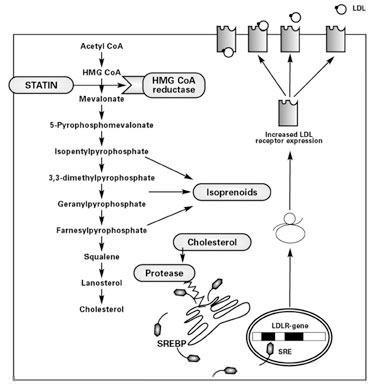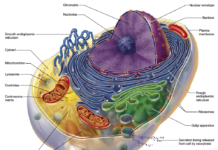By Jim English
Statin compounds are potent cholesterol-lowering agents that are extremely effective at lowering LDL levels and reducing risk of cardiovascular disease. Now, after a decade of impressive clinical success, a growing body of research is revealing a number of unexpected health-enhancing and potentially life-extending benefits of statins.
In addition to lowering cholesterol levels and dramatically reducing heart attacks and strokes, statins have been shown to reduce overall mortality and improve health status in other ways. Research indicates that statins may substantially reduce the risk of bone fracture in the elderly, and can profoundly lower the incidence of the devastating neurological disorder, Alzheimer’s disease, by up to 73 percent.
In this article we examine statin compounds, both synthetic (Mevacor, Provachol) and natural (Red Yeast Rice Extract), and review the growing list of health benefits of this remarkable substance.
NIH Expands Use of Statins
In light of these new discoveries, medical researchers and health experts have called for the increased utilization of statins to improve health and prolong life. According to Dr. Ronald Krauss of the University of California, Berkeley, “We can dramatically reduce the risk for coronary heart disease by lowering blood cholesterol levels, even in the range that we had traditionally considered as being relatively normal.” (1)
Other experts have expressed the need to expand the use of statins to include not just those with high cholesterol, but also those with diabetes, high blood pressure, high serum levels of triglyercides, low levels of HDL, and those with a strong family history of heart disease. “If you look at the statins and you look at the evidence for reductions in heart disease, for saving of lives, for their safety, they have to rank…as good as any drugs created for any disease since penicillin for pneumococcal pneumonia,” said Dr. Henry Ginsberg of Columbia-Presbyterian Hospital in New York.” (1)
In response to the overwhelming effectiveness of statins and the calls for greatly expanded utilization, on May 15, 2001 the National Institutes of Health (NIH) released aggressive new health guidelines that may dramatically increase the use of statins to reduce cholesterol levels and cut deaths from heart disease. The new federal guidelines, Third Report of the Expert Panel on Detection, Evaluation, and Treatment of High Blood Cholesterol in Adults (Adult Treatment Panel III), are expected to increase the number of Americans taking statin drugs from 13 million to 36 million. (2)
Among new recommendations as candidates for statin therapy are people with diabetes and those with a metabolic syndrome now commonly referred to as “Syndrome X.” Syndrome X is a combination of risk factors for heart disease including obesity – particularly abdominal fat – high blood pressure, and hyperinsulinemia.
“The metabolic syndrome has emerged as being as strong a contributor to early heart disease as cigarette smoking,” said Dr. Scott Grundy of the University of Texas Southwestern Medical Center in Dallas, chairman of the panel that drafted the recommendations. (3)
Cholesterol Pathway
Cholesterol is a vital fatty component of all cell membranes that is required to maintain cellular integrity and synthesize hormones. Elevated serum levels of this waxy substance (hypercholesterolemia) are known to increase the incidence of Coronary Heart Disease (CHD), a major risk factor for heart attack and stroke. CHD is currently the leading cause of death in the United States, killing over 500,000 people annually.
Cholesterol is transported through the body by two specialized carrier proteins – low-density lipoprotein (LDL) and high-density lipoprotein (HDL). Because higher levels of HDL seem to confer protection against heart attacks and strokes, HDL cholesterol is often referred to as the “good” cholesterol. Scientists believe that HDL plays a role in removing excess cholesterol from atherosclerotic arteries and retarding the growth of new plaque. Conversely, low levels of HDL cholesterol are seen as an indication for increased risk for developing coronary heart disease.
LDL, the “bad cholesterol,” is the primary carrier of cholesterol in the blood. When LDL is oxidized by free radicals it forms a thick, hard plaque that accumulates within the walls of arteries. This condition, known as atherosclerosis, restricts the flow of blood and oxygen to the heart, brain and other organs. If a clot (throm-bus) blocks an artery previously restricted by plaque, the flow of blood and oxygen can be cut off entirely, leading to a heart attack if the occlusion occurs in the heart, or a stroke if occurring in the brain.
Lowering Cholesterol with Statins
While cholesterol levels can be modestly lowered 5 to 10 percent by dietary modification (i.e., reducing ones intake of saturated and trans-fatty acids) most cholesterol (about 80%) isn’t derived from dietary sources but is synthesized in the body. A key enzyme known as HMG-CoA reductase controls the process of synthesizing cholesterol in the liver (Fig. 1). Statin compounds have been shown to be highly effective in inhibiting HMG-CoA reductase and thereby reducing the production of cholesterol, contributing to an overall reduction in blood LDL cholesterol levels. (4)

Fig. 1. Inhibition of HMG CoA reductase reduces intracellular cholesterol levels; this activates a protease, which in turn cleaves sterol regulatory element-binding proteins (SREBP’s) from the endoplasmic reticulum. The SREBP’s translocate to the nucleus where they upregulate expression of the LDL receptor gene. Enhanced LDL receptor expression increases receptor-mediated endocytosis of LDL and thus lowers serum LDL. Inhibition of HMG CoA reductase also reduces intracellular levels of isoprenoids, which are intermediates in cholesterol biosynthesis. (From the American College of Cardiology. Vaughan, CJ, Gotto, AM, Basson, CT. J Am Coll Cardiol 2000; 35:1).
Statin therapy has contributed to the substantial decrease in CHD morbidity and mortality in recent years, as documented in a number of controlled clinical trials. (4) Although statin therapy was first used for patients suffering from severe hypercholesterolemia, more recent trials have shown benefit for patients with moderately elevated cholesterol. In addition to improvements in lipid profile, statins appear to confer other benefits, including improved endothelial function, decreased platelet thrombus formation, improved fibrinolytic activity and reduction in frequency of transient myocardial ischemia. (5)
Statins Reduce Alzheimer’s
Alzheimer’s disease is a chronic and progressive degenerative neurological condition that currently afflicts over 4 million people in the US. Alzheimer’s commonly appears after age 50, and from age 65 on, risk of developing the disease doubles with every additional 5 years of age.6 Alzheimer’s is associated by deposits of a naturally-occurring key protein called amyloid. In Alzheimer’s, beta-amyloid accumulates in unusual plaques and tangles throughout brain structures, leading to dementia, behavioral symptoms and loss of brain tissues (Fig. 2). A growing body of research suggests that cholesterol-lowering statin drugs are effective in reducing amyloid plaque production thereby decreasing the likelihood of developing Alzheimer’s disease.
In the October, 2000 issue of the Archives of Neurology, a multicenter team of researchers reported that the risk of developing Alzheimer’s disease was reduced by up to 73 percent in older patients being treated with two popular cholesterol-lowering drugs, lovastatin and pravastatin. Dr Benjamin Wolozin, of Loyola University Medical Center, and co-authors reviewed information collected from three hospital databases covering more than 60,000 patients aged 60 years and older. The researchers found that use of these two statins reduced the risk of probable Alzheimer’s disease by 69.6 percent compared with the patients in the population as a whole, and by 57.3 percent to 73 percent compared with patients using other medications for hypertension or cardiovascular disease. They report that their findings were consistent with previously published data on an observed link between high serum cholesterol levels and an increased risk of Alzheimer’s. (7)
In a second, more recent study, researchers reported that two cholesterol-lowering statin drugs were effective in reducing intracellular and extracellular levels of amyloid. Writing in the April 10, 2001 Proceedings of the National Academy of Sciences, a team of German researchers measured levels of two forms of beta-amyloid, Abeta42 and Abeta40, in tissue cultures of brain neurons from rats that were treated with simvastatin and lovastatin.
“Simvastatin lowered the production (of the beta-amyloid protein) Abeta42, decreasing the likelihood of Alzheimer’s disease,” wrote co-author Dr. Tobias Hartmann of the University of Heidelberg in Germany. The team stated that “Lowered levels of Abeta42 may provide the mechanism for the observed reduced incidence of dementia in statin-treated patients and may open up avenues for therapeutic interventions.” (8)
When they repeated their test with animals, the research team discovered that when guinea pigs were fed diets containing statin drugs, both simvastatin and lovastatin behaved similarly, reducing the production of Ab42 and Ab49 in the cerebrospinal fluid and brain tissues. Accord-ing to the authors, guinea pigs provide a good model for studying Alzheimer’s disease, as they produce amyloid proteins very similar to human ones, and their reaction to statins is similar to that shown by humans.
“This opens up new therapeutic approaches to Alzheimer’s disease,” wrote Dr. Benjamin Wolozin in an editorial accompanying the study. “The ability of statins to reduce amyloid beta production offers the exciting prospect that an existing medicine might be effective in delaying the onset or progression of Alzheimer’s disease.’’
Synthetic Statin Drugs
When cholesterol levels are dangerously elevated, the current mainstream medical response is to prescribe any of a number of several synthetic forms of HMG-CoA reductase inhibitor drugs, including: fluvastatin (Lescol®), cerivastatin (Baycol®), atorvastatin (Lipitor®), simvastatin (Zocor®), pravastatin (Pravachol®) and lovastatin (Mevacor®). While statin drugs are effective at lowering LDL cholesterol and relatively free of serious effects, they do have one serious drawback – they are expensive to use. Depending on dosage, lovastatin therapy can cost between $63-$228 per month. (9)
Red Yeast Rice – The Natural Statin
In addition to the expensive synthetic statin drugs, lovastatin also occurs naturally as a food product called red yeast rice extract. This discovery was the result of a search by Chinese medical researchers for an affordable alternative to the prohibitively expensive pharmaceutical statins used in the West. (10) As they examined traditional Chinese medicinal records for clues, the researchers discovered that ancient Chinese medical scholars were prescribing red yeast rice extract to promote blood circulation and reduce clotting as far back as Ming Dynasty (1368-1644). (11)
Acting on this information, the Chinese researchers took a closer look at red yeast rice extract, a flavoring and food coloring agent that has been used in Chinese cooking for over two thousand years. Chinese researchers discovered that red yeast rice extract contains a number of compounds that act as HMG-CoA reductase inhibitors. The most abundant of these, lovastatin, is the same cholesterol-lowering ingredient found in Mevacor. Ongoing research has also uncovered the presence of a number of unsaturated fatty acids not found in the synthetic statin drugs that appear to promote lower triglyceride levels while increasing HDL levels.
Like the synthetic statins, red yeast rice extract has been shown to be highly effective in reducing serum cholesterol levels. Chinese researchers have demonstrated that red yeast rice extract effectively reduced LDL levels an average of 24.6% in a randomized, single-blind trial with 502 patients diagnosed with hyperlipidemia. (12) Patients taking 600 mg of red yeast rice twice a day (1200 mg/d) for eight weeks showed a number of substantial improvements in their lipid chemistry, including:
- LDL levels declined an average of 30.9%.
- Serum triglycerides declined an average of 34.1 %.
- HDL levels increased by 19.9%.
- Total cholesterol levels decreased significantly by 22.7%
The authors of the study stated that red yeast rice is a “highly effective and well-tolerated dietary supplement that can be used to regulate elevated serum cholesterol and triglycerides.”
American clinical trials have also demonstrated benefits that are consistent with the scientific studies in China. Dr. David Heber of the UCLA found that 83 volunteers taking red yeast rice supplement for eight weeks experienced an average 17% reduction in cholesterol levels, as opposed to those taking a placebo. All patients in the randomized study ate a healthy diet, but only those taking the supplement saw a cholesterol benefit. (13)
A second study, directed by Dr. James Rippe of Tufts University School of Medicine in Boston, found similar results when 233 people were given a proprietary form of red yeast rice extract for eight weeks. Doctors at twelve medical practices across the country reported that patient cholesterol levels fell from an average of 242 to 206. (14)
Conclusion
Red yeast rice extract has been proven effective in a number of clinical trials for promoting healthy cholesterol levels. Lovastatin, the main active ingredient in red yeast rice, has been extensively researched and found to be extremely effective at lowering cholesterol levels and dramatically reducing heart attacks and strokes. Statins have also been shown to reduce overall mortality, to reduce the risk of bone fractures, and to lower incidence of Alzheimer’s disease by up to 73 percent. Red yeast has been proven as effective as pharmaceutical statin drugs, such as Mevacor, but at about one-fifth the cost, and is available without a prescription.
Side Effects
Human studies with red yeast rice extracts shows it to be well tolerated. A small number of side effects have been observed, including muscle cramps, fatigue and dizziness. All side effects resolved upon discontinuation of the product. Use of statins has been shown to result in lowering of levels of CoQ10. Research shows that this effect is resolved by supplementation with Coenzyme Q10 – i.e. 100 mg of CoQ10 – not only countered this effect, but resulted in a significant increase of plasma CoQ10 levels (see Exogenous CoQ10 preserves plasma ubiquinone levels in patients treated with 3-hydroxy-3-methylglutaryl coenzyme A reductase inhibitors below).
Abstract
Exogenous CoQ10 preserves plasma ubiquinone levels in patients treated with 3-hydroxy-3-methylglutaryl coenzyme A reductase inhibitors.
Bargossi AM, Battino M, Gaddi A, Fiorella PL, et al. Int J Clin Lab Res 1994;24(3):171-6.
Ubiquinone is a carrier of the mitochondrial respiratory chain which regulates oxidative phosphorylation: it also acts as a membrane stabilizer preventing lipid peroxidation. In man the quinone ring originates from tyrosine, while the formation of the polyisoprenoid lateral chain starts from acetyl CoA and proceeds through mevalonate and isopentenylpyrophosphate; this biosynthetic pathway is the same as the cholesterol one. We therefore performed this study to evaluate whether statins (hypocholesterolemic drugs that inhibit 3-hydroxy-3-methylglutaryl coenzyme A reductase) modify blood levels of ubiquinone. Thirty unrelated outpatients with primary hyper-cholesterolemia (IIa phenotype) were treated with 20 mg of simvastatin for a 3-month period (group S) or with 20 mg of simvastatin plus 100 mg CoQ10 (group US). The following parameters were evaluated at time 0, and at 45 and 90 days: total plasma cholesterol, high-density lipoprotein-cholesterol, low-density lipoprotein-cholesterol, triglycerides, Apo A1, Apo B and CoQ10 in plasma and in platelets. In the S group, there was a marked decrease in total cholesterol low-density lipoprotein-cholesterol and in plasma CoQ10 levels from 1.08 mg/dl to 0.80 mg/dl. In contrast, in the US group we observed a significant increase of plasma CoQ10 (from 1.20 to 1.48 mg/dl) while the hypocholesterolemic effect was similar to that observed in the S group. Platelet CoQ10 also decreased in the S group (from 104 to 90 ng/mg) and increased in the US group (from 95 to 145 ng/mg).
References
1. R. Bazell, www.msnbc.com/news/566764.asp
2. Third Report of the Expert Panel on Detection, Evaluation, and Treatment of High Blood Cholesterol in Adults (Adult Treatment Panel III) www.nhlbi.nih.gov/guidelines/cholesterol/index.htm
3. www.cnn.com/2001/HEALTH/conditions/05/15/
cholesterol.health/index.html
4. Farmer JA. Aggressive lipid therapy in the statin era. Prog Cardiovasc Dis 1998;41:71-94.)
5. Farnier M, Davignon J. Current and future treatment of hyperlipidemia: the role of statins. J Cardiol 1998 Aug 27 82:4B 3J-10J.
6. Alzheimer’s Association, General Statistics and Demographics, www.alz.org/hc/overview/stats.htm.
7. Wolozin B, Kellman W, Ruosseau P, Celesia GG, Siegel G. Decreased prevalence of Alzheimer disease associated with 3-hydroxy-3-methyglutaryl coenzyme A reductase inhibitors. Arch Neurol 2000 Oct;57(10):1439-43.
8. Fassbender K, Simons M, Bergmann C, Stroick M, Lutjohann D, Keller P, Runz H, Kuhl S, Bertsch T, von Bergmann K, Hennerici M, Beyreuther K, Hartmann T. Simvastatin strongly reduces levels of Alzheimer’s disease beta-amyloid peptides Abeta 42 and Abeta 40 in vitro and in vivo. Proc Natl Acad Sci USA 2001 Apr 10.
9. Perreault S, et al. Treating hyperlipidemia for the primary prevention of coronary disease. Are higher doses of lovastatin cost-effective? Arch Intern Med 1998;158:375-381.
10. Wang J, Zongliang L, Chi J, et al. Multicenter clinical trial of the serum lipid-lowering effects of a Monascus purpureus (Red Yeast) rice preparation from traditional Chinese medicine. Curr Ther Res 1997;58:964-978.
11. Heber D. Natural Remedies for a Healthy Heart. Garden City Park, NY: Avery; 1998.)
12. Wang J, Zongliang L, Chi J, et al. Multicenter clinical trial of the serum lipid-lowering effects of a Monascus Purpureus (Red Yeast) rice preparation from traditional Chinese medicine. Current Therapeutic Research 1997;58(12):964-78.
13. Cholesterol-lowering effects of a proprietary Chinese red-yeast-rice dietary supplement.
Heber D, Yip I, Ashley JM, Elashoff DA, Elashoff RM, Go VL, Am J Clin Nutr 1999 Feb 69:2 231-6.
14. A “Natural” Remedy for High Cholesterol. The Johns Hopkins Medical Letter, July 1999 Vol. 11;5. p.3.
15. Folkers K, Langsjoen P, Willis R, Richardson P, Xia LJ, Ye CQ, Tamagawa H. Lovastatin decreases coenzyme Q10 levels in humans. Proce Natl Acad Sci USA 1990 Nov 87:22 8931-4.













